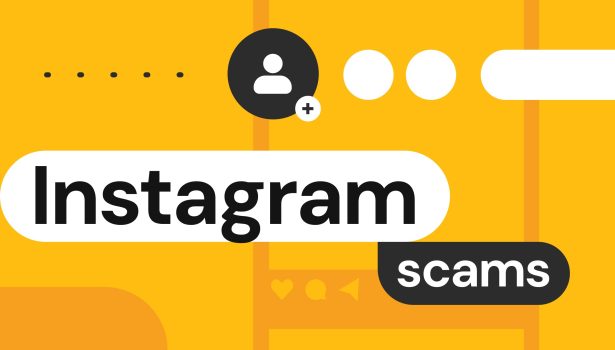Instagram scams in 2025: how to identify, avoid and fight back

With more than 2 billion monthly active users, Instagram is a go-to social platform for many—and scammers take advantage of it. Similar to Facebook scams, fraudsters are drawn to Instagram because of both its vast audience and the ease of contacting strangers under seemingly legit premises. They’re often successful in defrauding people of money and stealing their sensitive information, abusing the victims’ trust and digital naivete.
This guide from Onerep covers the most common Instagram scams going around, so you know what to avoid and how to protect yourself from con artists and bots preying on Instagram users.
Common types of Instagram scams
Instagram scams take many forms, from fake influencer giveaways to investment opportunities that bring nothing but financial loss. These scams are enabled through fake accounts that run rampant on Instagram, where identity verification is optional. Some of these scams start with a DM from an unknown contact, others are carried out through hijacked accounts of celebrities, well-known organizations, or even close friends.
Muse scam
The so-called muse scam frequently targets artists and other creatives, who are approached by strangers complimenting their work and offering an attractive sum of money for permission to use their photograph or artwork as an inspiring muse in a “client project” or mural.
The payment is usually sent via check, and the artist is asked to cover a certain amount of money to pay for “materials.” The check later bounces, leaving the artist with a financial loss, often worsened if they transferred the requested funds before the check cleared.
Only accept artistic commissions from organizations and agencies whose legitimacy you can verify. Ask the contact person to provide a professional email address, sample work or contracts, and reverse-search their profile picture to see if it’s stolen.
Impersonating friends and relatives
Instagram impersonators may hijack your friends’ or relatives’ accounts, or create fake accounts mimicking them using stolen photos.
These scams are dangerous, as the trust level is high by default, so the victim may take some time to realize the familiar face is actually fake. Meanwhile, scammers have ample time to manipulate the target into believing they need money to cover an emergency or travel expenses.
Look for signs like odd usernames, unnatural grammar, or a tone of voice that feels “off.” Contact the person through another known channel to verify the information.
Phishing scams
Phishing scams come in various forms, but all aim to manipulate users into clicking a seemingly legitimate link and giving away their personal details or credit card information.
Fake login pages mimic Instagram’s design but differ slightly in details. Nevertheless, users are rarely vigilant enough to spot the difference, which is how their Instagram credentials can be stolen, allowing scammers take over their accounts and further target the victim’s followers.
Voting phishing scams involve someone inviting you to vote for them in a competition or for a certain role. The fake voting page requires you to enter your Instagram or Facebook credentials, which are then promptly stolen, as the login page is a spoofed version of the official one.
Impersonating well-known and trusted influencers can make people fall for phishing links sent to them or move over to WhatsApp or Telegram and share sensitive information and money in private communication.
To avoid falling for this scam, never click links shared in unsolicited messages or via sketchy profiles, especially if they’re disguised with a link shortener, and verify that the URLs match the official ones with no misspelling.
Instagram promotion scams
This is one of the most common types of Instagram money scams, featuring fake offers to help Instagram users grow their accounts. These scams target creators, small businesses, or individual users, promising promotion on high-traffic pages, shoutouts to thousands of followers, partnerships with influencers and so on, in exchange for an advance fee. This fee is typically requested via crypto or instant money transfer services, like in Zelle scams. Once the fee is paid, the scammer disappears, delivering none of what was promised.
If you’re approached by someone asking to be paid for growing your follower base, vet their information carefully and avoid sending any money unless you conclude a formal contract and agree to use a secure payment method, such as PayPal Goods & Services.
Instagram support impersonation
A variation of the impersonation scam, this one involves fake emails or DMs from accounts posing as Instagram customer support. These messages may include alerts about “suspicious activity in your account” or requests to “verify your account” due to intellectual property violations or other Community Guidelines issues. These messages typically contain phishing links that lead to fake forms designed to steal login information.
Know that Instagram or Meta support may only contact users via email using their official domains, as listed in the How to spot an Instagram scam section below.
Get-rich-quick scams
Instagram is a hotbed of financial scams, including all types of fraudulent investment and money-flipping offers. Cryptocurrency is often featured prominently in these scams, as crypto transactions are instant and final, and the recipient’s true identity is anonymous.
Get-rich-quick scams on Instagram may take these forms:
- Money flipping scams, like “send me $100, turn it into $1,000 in a day.”
- Cryptocurrency investment scams, sometimes using fake trading dashboards to manipulate victims into thinking they’re turning a profit, or impersonating celebrities to build trust.
- Fake lotteries and giveaways that start with a DM saying you’ve won a prize, but to claim it you need to cover a small shipping or verification fee, provide your credit card information, or click a link to redeem your prize. All of this leads to either money or Instagram credentials being stolen.
Scammers often use fake testimonials and forged screenshots showing incredible returns on investment or other users rejoicing over their win, using bots and doctored images for social proof.
Offers that are too good to be true are classic scam tactics, so steer clear of them, no matter how high the promised returns are.
Commerce scams
Just like with Facebook Marketplace scams, fake Instagram sellers may offer non-existing or counterfeit goods at prices that are too good to be true. To purchase, you’re typically asked to move off the platform to a messenger app and use an instant money transfer service to pay upfront, either the full amount or a deposit to “reserve” the item. Once you pay, the scammer disappears.
Never purchase anything from strangers online unless platform-based purchase protection is available. Meta offers purchase protection only for items bought using their official on-site checkout.
Influencer scams
With their network of followers and trust-based relationships already established, influencers and high-value targets for scammers on Instagram.
They may be approached by scammers posing as famous brands with lucrative offers of collaboration. However, these fake collaboration often require influencers to share banking details via a form, “verify” their wallet for crypto deals, or even pay an upfront “sign-up fee” to join a fake influencer program. Scammers may also steal the influencer’s Instagram credentials via a phishing link disguised as a “contract” or “collaboration agreement.”
In other cases, influencers may unknowingly help scam their own followers. Scammers may copy a legitimate giveaway post but include phishing links or require “winners” to send money or cover “shipping fees” to claim featured products.
Avoid interacting with accounts that are not verified or with contacts who can’t prove their official affiliation with a brand. When asked to collaborate, never send sensitive information or money, as no legitimate company would require that in order to work with them.
Romance scams
One of the most common types of scams out there, Instagram dating scams follow the same pattern: a scammer reaches out of the blue, develops a close bond quickly, and then, after establishing trust, invents some personal crisis that urgently requires money. They may also ask for money to fly them over or to help their family in need.
In a more elaborate version of this Instagram romance scam—known as a pig butchering scam—the con artist may urge the victim to join an investment scheme they’re part of, typically related to cryptocurrency trading, and disappear once they defraud the person of a hefty sum.
Regardless of how real the connection feels, avoid sending money or trusting investment advice from someone you have never met in person, especially if they avoid video calls and you sense something fishy is going on.
Donation scams
Scammers may approach with pleas to raise funds for natural disaster relief efforts, medical emergencies, animal rescue, or personal tragedies via GoFundMe or any other popular crowdfunding platforms, or direct money transfers. In doing so, they may impersonate real charities, hijack real fundraising campaigns, or run fake accounts.
If you’re considering supporting a cause, do so via its official verified channels. Scammers are known to use deepfake AI technologies to impersonate celebrities, so stay cautious and only transfer money using payment methods that offer anti-scam and fraud protection.
How to spot an Instagram scam
Scams often start with a direct message. If you ever get one from a stranger, analyze it for the following common red flags:
- Contacts from suspicious accounts that are new, have no profile photo, few or zero followers and posts.
- Strangers contacting you out of nowhere and claiming to have a crush on you or complimenting your looks or artworks.
- Excessive flattery, a sense of urgency, or an emergency that requires your instant attention.
- Alerts about losing your account access due to some issue with it or the authorship of your content.
- Strangers asking for money, usually through untraceable methods as part of CashApp scams or Venmo scams.
- Celebrities or representatives of well-known organizations contacting you from unverified accounts.
- Claims of guaranteed profits, stories of crypto gains, and screenshots of excited user testimonials showing high investment returns.
- Requests for an upfront fee to promote your account or claim a prize in a lottery or giveaway.
- Instagram or Meta support representatives asking for sensitive information, such as your username, password or verification code.
- Messages with poor grammar and punctuation, strange spacing, or unusually long explanations of why the target should act in a specific way instead of a normal one.
To spot a phishing attack via a fake login page, look for fonts, wording, and layout that seem slightly off. Check that the URL matches the official domains—that is, instagram.com, fb.com or facebook.com.
If you get a suspicious email claiming to be from Instagram, verify if it’s among the recent emails Instagram sent you. Instagram’s official email communication is sent out from the following authorized domains:
- @support.facebook.com
- @support.instagram.com
- @facebookmail.com
- @mail.instagram.com
- @global.metamail.com
What to do if you’ve been scammed on Instagram
- First, report the scam. You can report anything that breaks Instagram’s Community Standards through the feed or the user’s profile. There’s the dedicated Scam, Fraud or Spam section among the reporting reasons, along with the option to report a user who is pretending to be someone else. If you got scammed via a phishing email, forward it to phish@instagram.com.
- If you think you’ve been scammed, it’s critical to secure access to your account, if you can still log in. Change the password to both Instagram and Facebook (if they’re connected), and enable two-factor authentication so no one can break into your account just by knowing your credentials.
- Remember that scammers can take over both your Instagram and Facebook accounts if you’ve opted for the Meta’s unified login. In this case, they may change your password and lock you out of the system while gaining access to your network of Facebook friends and linked Pages. In this case, it’s important to secure your Facebook account as well, opt out of the unified login, and use two different passwords for each application.
- If you shared your bank card details or received/sent any money to the scammer, contact your banking institution or payment card issuer to try to reverse the transaction and set up fraud alerts.
- In all cases, report the scam to the Federal Trade Commission or the FBI’s Internet Crime Complaint Center (if you’re based in the U.S.), or to the anti-fraud organization in your jurisdiction.
- Lastly, if your account was hacked, don’t fall for Instagram account recovery services as this can be another scam that further capitalizes on your loss.
How to protect yourself from Instagram scams
As there is no single Instagram scammer list available, it takes vigilance, digital security awareness, and common sense to spot a scam on Instagram.
First, it helps to adopt proven best practices that are effective for securing all accounts, not just Instagram. These include:
- Using strong, unique passwords that you don’t reuse anywhere else.
- Enabling two-factor authentication via a mobile authentication app (not SMS texts) for added security.
- Turning on login alerts so you’re notified when someone tries to access your account.
Additionally, follow these recommendations to protect yourself from falling into a scam trap:
- Don’t click suspicious links or download attachments from unknown contacts or those whose identity and legitimacy you can’t reliably verify.
- Don’t log into your Instagram or Facebook account via links shared in DMs, even if they come from people you allegedly know.
- Never respond to anyone asking for personal sensitive information, including account credentials, bank card details, your Social Security number, or verification codes.
- If contacted by a seller, verify their information by clicking “About this account” in their profile. This will show the date they created their account, their country, and any past usernames.
- Do a reverse image search on the contact person’s profile photo and any images or videos they share with you while negotiating a transaction.
In all cases, trust your gut and use common sense to avoid Instagram scams. If something feels suspicious, it probably is. Don’t hesitate to block and report potential scammers to protect yourself and other Instagram users.
How Onerep helps shield your online identity
When you snap back at scammers, they may use scare tactics and threats, trying to manipulate you by claiming they know your home address, workplace, or relatives. Know that this information can often be easily obtained by anyone through public data brokers, and people-search websites, or simply by googling.
Onerep makes it harder for scammers to access your personal sensitive information and use it to intimidate you. We remove publicly available information about you from 200+ websites, including Google. This helps minimize your online footprint and makes you a less likely target for scammers, especially those using social engineering tactics.
FAQs
What are the most common Instagram scams?
The most common scams on Instagram include various money scams like cash flipping or fraudulent crypto investments, romance and dating scams, impersonation of celebrities, well-known brands, charities, and friends or relatives, fake giveaways, and fake brand collaboration offers targeting influencers.
Can someone scam you just by messaging you on Instagram?
Yes, it’s possible to scam someone through DMs. Scammers can trick victims into sharing sensitive information, Instagram login details, and bank card data, making payments, or investing in fraudulent schemes and losing money.
How do I report a scammer on Instagram?
Go to the scammer’s profile, click the three-dot menu, and choose the Report option. Under the reporting reasons, choose Scam, Fraud or Spam. You can also report specific messages, posts, and stories.
Is it safe to accept random DMs or followers?
It’s not safe to accept random DMs, as they can be gateways to scams. Accepting followers is generally okay unless they message you or leave comments with suspicious offers and links. In this case, it’s safer to block the person from contacting you.
What happens if you send money to a scammer?
Once you send money to a scammer, usually via crypto, a payment service like Zelle, or gift cards, it’s gone for good. These transactions are rarely refunded, and recovering funds is difficult without law enforcement or the payment platform’s intervention.





Dimitri is a tech entrepreneur and founder of Onerep, the first fully automated data removal service. Top cybersecurity CEO of 2021 by The Software Report.